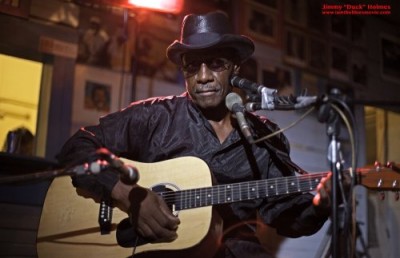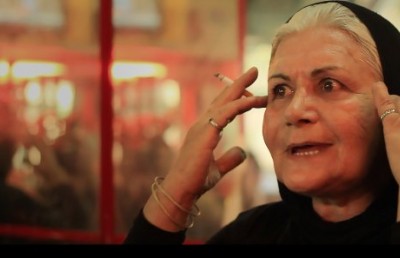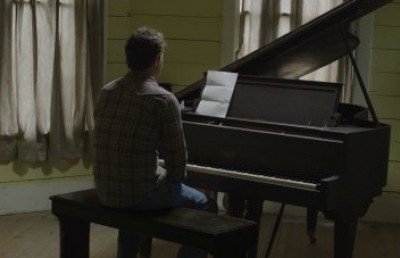Whole Lotta Motherlove: The Baby (1973)
Independent Cult Classic
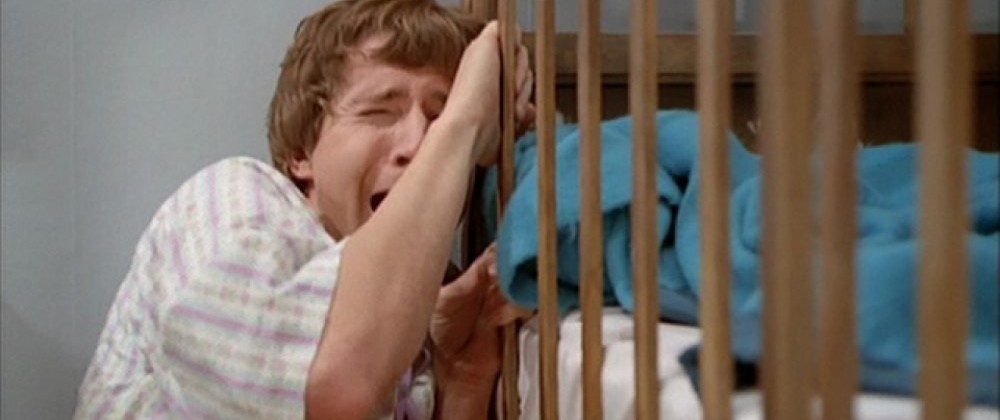
Film studies is not an exact science; it’s a series of interpretive methods. Watching a film yields several possible subjective readings, concerning not just the text itself but the time in which it was made, and these readings are naturally filtered through our own contemporary lens. So we end up with a double glance at ourselves, completing the mythmaking function innate to all narrative art. Narratives exist because they tell us what we already know. In the early 1970s what we knew was that the world was in tumult: it was the height of Vietnam, civil rights, black power and the women’s movement. Between 1968 and 1975 —that transitional era known as New Hollywood— the American film industry, or some of its denizens, sought to express change and its consequences in a series of films, which spoke to a captive audience. Feminism was at its height yet Hollywood’s key formal variant of the 1960s, the buddy film, was the most popular and dominant film narrative.
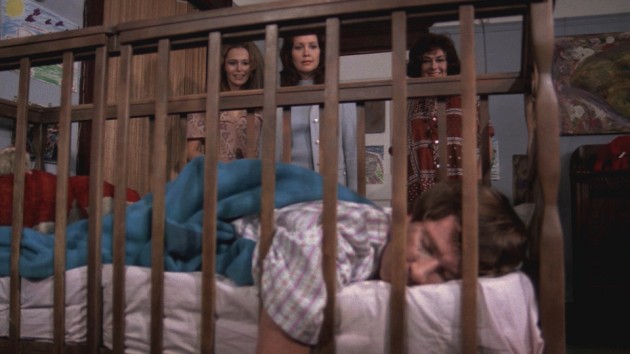
At home with the Wadsworths
Released in March 1973, The Baby remains one of the unappreciated oddities of the time. It relates the tale of a suburban Mom, Mrs Wadsworth (Ruth Roman) and her three fatherless adult children, the youngest of whom, Baby (David Manzy) is in his twenties but still behaves like an ungainly diaper-swaddled newborn. Mrs Wadsworth’s unconventional household makes her the focus of social workers’ attention: when one of them, Ann Gentry (Anjanette Comer), expresses a particular interest in the family’s situation, nobody could guess that she might have an ulterior motive. The true seat of horror here resides not in this anti-bourgeois unit but in the external agencies attempting to separate the various elements. The extraordinary and shocking conclusion to which the narrative perversely drives is the factor which appears to place The Baby into the irretrievable realm of bad taste and cult. Danny Peary says of cult movies that
…they characteristically feature atypical heroes and heroines; offbeat dialogue; surprising plot resolutions; highly original story lines; brave themes, often of a sexual or political nature; ‘definitive’ performances by stars who have cult status; the novel handling of popular but stale genres… [they] are born in controversy, in arguments over quality, themes, talent, and other matters. (Peary, 1981: xii)
The Baby fulfils these criteria with a certain degree of psychosexual glee. Taglines for the film include … ‘Pray you don’t learn the secret of … The Baby’; ‘Nothing in this nursery rhymes’; ‘Three Four Close the Door!’; ‘There shall be mayhem wherever he goes!’; ‘Horror is his formula!’ Etc. In the words of one commentator “this eerie little number is to cinema what Ed Gein is to psychopathology; it’s the equivalent of dancing around on your property wearing a mask made out of bacon and singing Debbie Boone songs, or papering every wall in your house with pictures of Uncle Fester.” (Jeffrey Leach)
Produced for Scotia International by writer Abe Polsky and his brother Milton, the company also acted as the film’s theatrical distributor. Polsky had written a number of screenplays such as Brute Corps (1972); the biker film, Rebel Rousers (1970) and he devised the story for The Gay Deceivers (1969); and he wrote episodes of Kung Fu for television (1972); however his main reputation is writing for the stage.
In their survey of American television directors, The American Vein (1979) Christopher Wicking and Tise Vahimagi cannot detect in director Ted Post’s work what they call a ‘distinct personality’ and their wonder at Clint Eastwood’s decision to hire him as director on his first non-spaghetti Western (Hang ‘Em High, 1968) is plain to behold. (106) It may well be Post’s reliable television experience which appealed to Eastwood, a history dating to 1952 and the Schlitz Playhouse of Stars. More than that, they knew each other well, since between 1959 and 1963 Post had directed twenty episodes of Rawhide – the series which had made Eastwood a name in the first place. Post therefore occupied a role in the ensemble of trusted collaborators with whom Eastwood has preferred to surround himself in his lengthy career. Immediately prior to The Baby, Post also directed an unusual film for television: Sandcastles was shot on videotape, an innovation for 1972. It recounts the tale of a musician (Bonnie Bedelia) whose car is involved in a collision on the Pacific Coast Highway, throwing the other car’s hitchhiking passenger (Jan-Michael Vincent) onto the wayside. She is inadvertently taken in by his friends, who are blissfully unaware of his death; meanwhile his beachwalking spirit haunts her waking hours. The film’s unusual quality is heightened by its transfer to film and it is here — as well as in Magnum Force (1973)— that Post’s penchant for the fantastic is to be truly seen, and not just in the title sequence (which is textbook Kenneth Anger). His taste for the contemporary —and somewhat controversial— would also be seen in The Harrad Experiment the following year. These choices would point to more than just happenstance in Post’s selection as director of The Baby —the film’s surrealistic bent and its comment on the fascistic elements in social agencies is consistent within that era at least of his body of work; and his preference for the fantastic recalls an episode of the TV series, The Twilight Zone, which he directed over a decade earlier. (The 1959 teleplay was entitled ‘A World of Difference’.)
Another commentator on The Baby notes that, “it’s unclear exactly what genre The Baby aspires to be (although the last half, complete with a musical score of dragging cellos and tinkly piano, heads unsteadily into horror territory). Then there’s the acting. And the screenplay. And the ending, which in any other film would be plain ludicrous, but at least here remains in keeping with the anti-logic of the rest of the story. What makes The Baby a sort of schlocky-campy classic (and surely a billing of ‘Strange Film Festivals’ everywhere) is its admirable disregard for reason. You can’t find holes in a story if there is no rational framework for which they can exist in. Nothing makes sense: characters do terrible things and earn no repercussions.” (Shane Burridge) However, it is clear that despite what Barry Langford describes as genre’s porosity and ‘leaky borders,’ that The Baby boasts several elements of what is known as the woman’s film, despite the seeming contradictions in the text (Langford, 2005: 159).
Melodrama operates as a safety valve for neuroses and desire, however inappropriate. Ultimately an ironic genre, it can never resolve the problems it poses for its characters and the audience.
Langford comments that it
… is often understood in terms of its contradictory imperatives to reveal and to repress issues, tensions and stresses around the family – the arena in and through which psycho-sexual identity is most importantly constituted – denied a ‘polite’ hearing in American society, or direct cinematic representation under the terms of the Production Code, hence its characteristic resort to the fantastic, the highly stylised and the ‘contrived.’ (Langford: 7)
And as Mary Ann Doane reminds us,
…the genre is the outcome of Hollywood’s analysis of its own market, its own grouping of films along the lines of sexual address. Filmic narratives and mise-en-scène are organised in the service of the production of female fantasy…their terms of address are dictated by the anticipated presence of the female spectator. (Doane, 1987: 3-4)
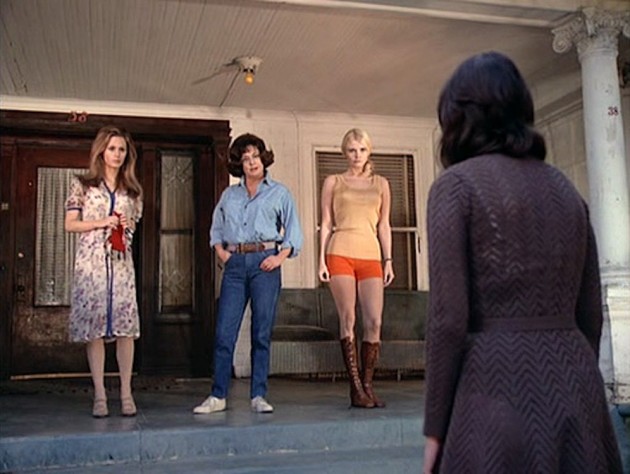
Greeting the Social Worker
The particular importance of melodrama as narrative form is its mirroring of structuring patterns of dominance in society: it speaks to the bourgeois of the bourgeois. At a time of social uncertainty it highlights difference, desire and disaster in internalised psychological form without necessary reference to societal strictures (Elsaesser in Mast, Cohen & Braudy, 1992: 518). It reached its peak in the nineteenth century with its capacity to reorganise moral order and articulate desire. The impossibility of closure makes the plight of the film family one of eternal compromise. The traditional overloading of paternal authority, the gender confusion of its progeny and the siphoning off of inappropriate rebellion into sexually unsatisfying marriage, all are elements which underlie the construction of the cinematic nuclear unit in melodrama. Its overwhelming failure to provide anything other than the ‘emergency exit’ ending has compromised its impact as narrative, although its importance as a fundamental mode of American cinema is not diminished. (Langford discusses its significance: 31. He refers to Linda Williams’ essay, ‘Melodrama Revised’.) Geoffrey Nowell-Smith says that
Because it cannot accommodate its problems, either in a real present or in an ideal future, but lays them open in their shameless contradictoriness, it opens a space which most Hollywood forms have studiously closed off. (Nowell-Smith, 1977)
So what occurs, cinematically speaking, when the tenets of the woman’s film are given a misogynistic twist? The era in which The Baby was made is a crucial factor in understanding its generic and historical origination. Its making is contemporaneous with ideological and social upheaval “signalled by a redefinition of sexual roles” (Doane: 3-4).
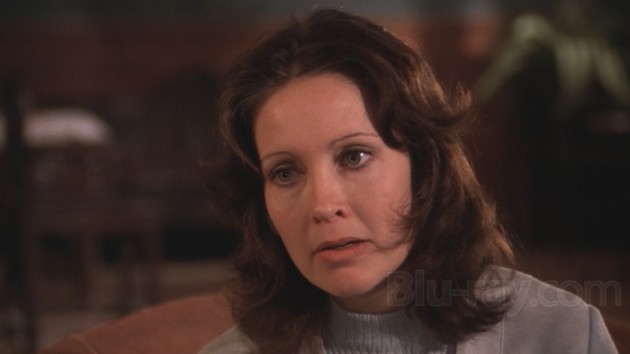
Ann Gentry (Anjanette Comer)
The film boasts some of the figures known to populate the woman’s film —the unwed mother, the abandoned wife, the career woman, the castrated male, the daughters who ‘act out’. In common with other woman’s films, it is also astonishing, as Jeanine Basinger comments, that
…these plots work. Women’s films are cautionary tales of a particularly desperate stripe, but they contain real passion, real anger. The lunacy verifies them. There’s something fabulous about the craziness, a kind of appealing madness … (Basinger, 1993: 6)
The melodrama frequently recasts its register according to its social context. Mary Ann Doane finds that there are four separate if complementary narratives within the melodrama, specifically the subsets of the woman’s film of the 1940s. In the maternal melodrama Doane states that
…an enforced or threatened separation between mother and child tends to produce an alignment of the mother with the figures of masochism. (Doane: 36)
When Ann Gentry persuades Mrs Wadsworth that Baby needs to be with other infants and acquire more developmental skills, Wadsworth reacts with deep-seated contempt: in the subset known as the medical discourse, the genre assumes the intervention of a male medical expert who is the guarantor of truth. The Wadsworth family constitutes a case history necessitating clinical help. Here, the intervention, while approved by a male superior, is instigated by the female, Ann, the guarantor of mayhem and murder, beholden to no recognisable social force other than the ironclad insanity of her husband’s mother. In the classic love story the extent of female desire is investigated; in The Baby Mrs Wadsworth’s very physique implies an excess of narcissism and self-satisfaction, her children living proof of sated lust, whereas the less prepossessing Ann Gentry suggests even by virtue of her name a less overwhelming libido. The lack of an obvious adult male to reciprocate the female desire which overwhelms the narrative is symptomatic of the sickness inflecting the genre and this film in particular. The Electra complex is inverted in female rivalry for the same man-child. And, finally, in the Gothic version of the woman’s story, marriage is linked with violence in a tale of female paranoia. In The Baby this is turned on its head, with the unmarried Mrs Wadsworth coming into conflict with a nominally married woman whose proclaimed interest in Baby shields an unhealthy obsession with infantilised men. (These paradigms are examined extensively by Doane). Ann Gentry is a woman dealing with grief. As Benjamin Lee states,
Film perpetuates the notion that, rather than gaining strength from their grief and ultimately learning to live with their loss, women are transformed into something monstrous, robbed of the softening glow that motherhood traditionally brings. (Lee, 2016: 13)
Lee continues:
Rather than seeking the restoration of some balance, she is an agent of chaos.
This is all too true of Gentry. Lee interviews sociologist Denise Turner who specialises in the reactions of bereaved parents:
It’s largely OK for men to be angry or vengeful —look at the ‘hero myth’— and if they feel vulnerable, that’s endearing. Women don’t have those cultural permissions and these things get acted out crudely and stereotypically in film.” (Ibid.)
There’s no doubt this is not a film with a serious social message: it’s a cult horror comedy and was intended as such. However the current array of films dealing with monstrous mommies and their grief reminds us that this is not a subject that has ever fully gone away: mainstream hit The Hand That Rocks the Cradle (Hanson, 1992) dealt with the same issue in a similarly perverse fashion, whilst Huntsman: Winter’s War (Troyan, 2016), The Ones Below (Farr, 2015) and Antichrist (Von Trier, 2009) have all handled the premise of deranged mothers with varying degrees of success and psychosocial commentary. As Lee concludes, “film continues to insist that the loss of a child turns a woman into a monster.” (Ibid.)
What are the contemporary threads that combine to create the tapestry of influences on the making of The Baby? The recent Grand Guignol cycle, perhaps, is one. Initiated by director and producer Robert Aldrich, Lukas Heller’s adaptation of the Henry Farrell novel, What Ever Happened to Baby Jane? (1962) sets the bar. Their re-teaming for Hush… Hush, Sweet Charlotte (1965), is a piece of Southern Gothic from the same novelist and starring once again the inimitable Bette Davis who would return to the same well for a number of late 60s British shockers. In What Ever Happened to Aunt Alice? (1969) Lee Katzin carries on the tradition. These films were big money spinners for the studios and gave drag queens a field day. A line of monstrous mothers that, for Joan Crawford, at least, in the form of Faye Dunaway, would conclude ingloriously in Mommie Dearest (Frank Perry, 1981) had its roots in the 1930s and 1940s and maternal melodramas like Stella Dallas (King Vidor, 1937) and Crawford’s own crowning moment, Mildred Pierce (Michael Curtiz, 1945). The later All That Heaven Allows (Douglas Sirk, 1955) and Madame X (David Lowell Rich, 1966) would provide a sentimental contemporary coda to earlier versions.
Andy Warhol’s alternative take on Hollywood also had its bourgeois moments —and in his parodic collaborations with Paul Morrissey, in films such as Flesh (1968), Trash (1970), Women in Revolt (1971) and Heat (1972), the deep-seated yearning desire that is the linchpin of melodrama can be seen in all its pathetic glory. Simultaneously, on the west coast, Stephanie Rothman was putting her own gloss on a series of films which presented an alternative view of the woman’s universe: in The Student Nurses (1970), The Velvet Vampire (1971), Group Marriage (1972) and Terminal Island (1973), exploitation combines with empathy to portray a truly liberated contemporary portrait of women in society.
Perhaps a direct influence on the writing of The Baby was a novel completed in February 1972 and published six months later. Ira Levin’s The Stepford Wives was a byproduct of the novelist and playwright’s response to his recent unpleasant divorce and also his reading of Alvin Toffler’s Future Shock. The merging of these sensibilities alongside Levin’s fascination with the animated figures in the Hall of Presidents at Disneyland led to Stepford’s sex toy fembots, apparently the ultimate desire of the contemporary paranoid yet upwardly mobile male. 1
Levin’s novel arguably falls between two stools —critiquing the wilder mores of both feminism and patriarchy. However it was a timely satire: published at the height of the women’s movement, it offered an amusing riff on that heady period. With, broadly speaking, the same narrative arc as the author’s previous satiric offering, Rosemary’s Baby —a woman suspects evil goings-on when she arrives in a new location and discovers ultimately that her paranoia is utterly justified— it was later (1975) filmed very effectively in an adaptation written and directed by Bryan Forbes. William Goldman remains credited as screenwriter but Forbes clarifies Goldman’s reluctance to produce anything beyond a first draft in his introduction to the Bloomsbury Film Classics edition of the novel issued with Sight & Sound: The Stepford Wives (London: Bloomsbury Publishing, 2000, vi.). The major change from the novel is the ending: in the book it is Joanna’s best friend, the robotised Bobbie, who murders her; whereas in the film, Forbes wrote a penultimate scene set in the Men’s Association in which Joanna runs around several gloomy corridors upstairs before being strangled by her robotised Other. Forbes also removes any mention of the black woman novelist whom Joanna befriends and who is also being set up by her husband for robotisation at the conclusion of the novel, although he keeps the scene in the supermarket which Forbes uses as the ending of the film.
It is variously categorised as science fiction, horror, and political thriller. Ultimately however it is a black comedy —a lesson barely acknowledged by the makers of the second, ‘comic’ version (2004) who presumably missed the humour (and the point) the first time around.
Are The Stepford Wives and The Baby the product of the same, male paranoia? The Baby effectively transmutes the Levin novel’s themes of liberation versus imprisonment into a suburban Californian locale with a hippie-ish unemployed mother and her two, scary, big-haired daughters, Germaine (exploitation regular Marianna Hill) and Alba (Suzanne Zenor), who look as though they might have stepped straight off Stephanie Rothman’s vampire film set. The eponymous male of the family is plainly adored by the women, and he loves them right back. When the seemingly well-balanced career woman steps into the breach and volunteers to give up more than her usually scheduled time to this particular case, there is no reason to be fearful. Social workers are generally perceived to be working in the interests of victims, particularly when it comes to an apparently perverse state of domestic affairs. However in true Hollywood fashion the social worker was suspect as far back as 1942 when career woman Marlene Dietrich in the comedy The Lady is Willing (Mitchell Leisen, 1942) is obliged to compensate for her success and take in an abandoned baby, she is accused of being self-centred (Marjorie Rosen: 14). In The Baby it is the social worker who is the contagion. As her pathological zeal is revealed we sympathise, too late, with the intimidating, if indolent, Mrs Wadsworth.
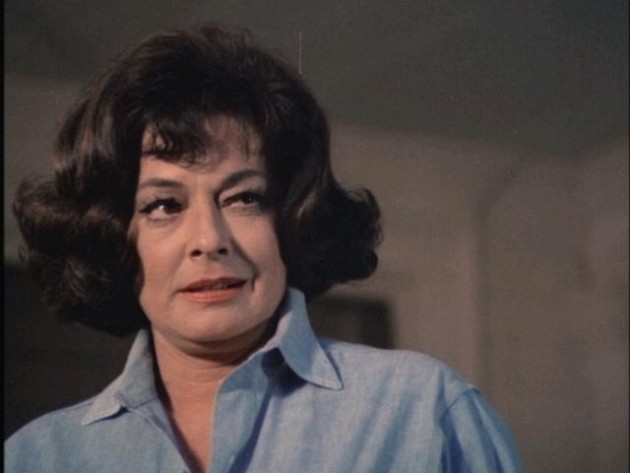
Mrs Wadsworth (Ruth Roman)
Motherhood, like apple pie, is part and parcel of the American Dream, and movies have implemented our romance with it as the ultimate feminine
contribution. (Rosen, 1973: 10)
In this film, maternal desire is truly abject. No depth of voyeurism or fetishism goes unplumbed: the usual forms of spectatorial desire are reversed so that the male man-child becomes the object of female fixation and obsession. In The Stepford Wives, the figure of perfection is the pre-programmed fembot wife; whereas in The Baby it is embodied in the man-child who can be breastfed in his twenties by the babysitter who just can’t help but help herself. Rosen notes,
Child worship seems …to be handmaiden to the glories of motherhood. (Rosen; 13)
Taken to its logical conclusion, The Baby’s makers suggest, too much motherlove can have a disastrous outcome. Baby —as he is called, because he has never been given anything so feudalistic as a name— hasn’t evolved to the stage where he can be castrated. He can’t walk or even speak. Pre-sexualised and devoid of individuality, he is the perfect symbol of the retarding of the male species in a matriarchal world. Motherhood is widely supposed to be the ‘antidote to selfishness’ but it can be excessive —the unhealthy limits of a woman’s obsessive childbearing are traced in The Pumpkin Eater (Jack Clayton, 1964).
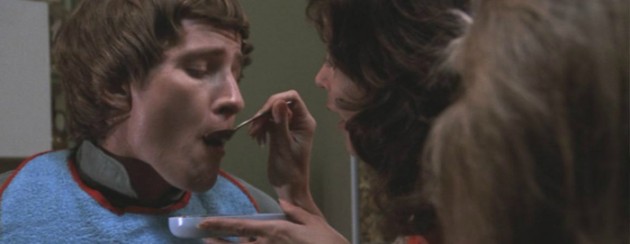
Feeding time for Baby (David Manzy)
In film the collapsing of maternal functions and the overlap with desire signals male paranoia. Mrs Wadsworth —a woman whose apposite surname seems to encapsulate a life of sexual abandon and voracious excess also figured in her ample shape— is not in fact the villain of the piece, despite her apparent over-investing of desire in Baby to the degree that he has not attained any sense of self. In a story twist that seems relentlessly contemporary, the matriarch of three more or less illegitimate adults is in fact the good mother. The threat to the family comes courtesy of social services and another, all-powerful matriarchal figure Judith (Beatrice Manley), who, in the Biblical tradition, is the antithesis of Mrs Wadsworth and a very bad mother indeed —and uses her daughter in law’s position in social services to wrangle a playmate for her son, lately retarded in an accident and now at a permanent stage of underdevelopment similar to Baby’s. The film therefore presents two forms of maternal excess, the one infinitely more dangerous than the other. The radicalism of The Baby resides in its turning of the apparently unstable mother, Mrs Wadsworth, into the moral centre of the drama, posited against the murderous repression of the covetous social worker and her crazed mother in law, to whom she is dangerously close. (This offers another twist to the Gothic narrative, which normally emphasises the closeness of mother and daughter.)
The film’s intensity and aberrance is linked to its intertextuality —in common with the paranoid woman’s film it is “infiltrated by the conventions of the film noir and the horror film” (Doane: 125). In The Baby the penultimate staircase scene is a replication of the many scenes of mis/recognition that populate the woman’s film. Doane says it is this space “which articulates the connection between the familiar and the unfamiliar, or between neurosis and psychosis” (Doane: 135-6). Here, the protagonist frequently meets her mirror image —the bad seed— in a form of cliffhanging confrontation.
… in the horror film, what the woman actually sees, after a sustained and fearful process of looking, is a sign or representation of herself displaced to the level of the nonhuman. In the paranoid woman’s film, on the other hand, the female character does not encounter a mutilated signifier of herself but, instead, the traces of another woman who once occupied her position as wife,…, or even her own iconic image… In both instances of self-confrontation, a narcissistic structure is produced by the collapse of the subject/object distinction. (Doane: 142)
In The Baby the only way back from Ann and Judith is down –and Mrs Wadsworth comes to an unpleasant end in a staircase sequence distinguished by its deep shadows, shafts of light, low angles, and haunting music track. (Interestingly, the penultimate scene in The Stepford Wives is strikingly similar and Joanna is eventually strangled by her robotised Other.) We are prepared for this dénouement by the mise-en-scène of the lead-in, with the Wadsworths’ saloon photographed at funereal pace and Germaine and Alba proceeding from within, their somnambulant daylight drifting ultimately transformed into surreal nocturnal tragedy at the Gentry home, the true locus of dread. The film’s conclusion is the ultimate return of the repressed. Behind this locked door lies …Mr Gentry, in a playpen, in another perverse twist on the paranoid narrative form. The circumstances of his retardation remain a secret.
The Baby was always destined for the drive-in circuit, the preserve for the most part of the South Western states that had made Billy Jack (Laughlin, 1971) a poster boy for independence. Perhaps the most astonishing aspect of the film’s reception was its PG rating.
How might we define it? Is it a woman’s film? Is it kitsch horror? Is it a bourgeois satire? Is it just grotesquery masquerading as social comment? Is it a paranoid man’s film? Is it a product of masochistic fantasy? Is it melodrama? It is all of the above, a product of its time, utilising various modes of sexual address to coincide with the confusing roleplay of the period. It fits with the external form of the woman’s film of the 1940s, which was also a product of ideological change and social upheaval, with Freudian paranoia, shifting sex roles and the growing strength of women in the workplace informing its content. Perhaps, as Basinger suggests,
Everything the woman’s film is, it also isn’t. Everything it endorses, it undermines. Everything it destroys, it reaffirms… These are not films that tell a lie, like many of Hollywood’s escapist dreams. These are films that tell the truth, but only because they are about the unhappiness of women. They’ll tell all the lies in the world to make that one point clear. (Basinger: 5)
She adds one final definition of the woman’s film to her book: “The presentation of the woman’s world allows for both an overt indication that women should lead conventional lives and a covert form of liberation in which they are shown doing something else or expressing anger about this need for conformity” (506). These contradictory impulses characterise the narrative in The Baby.
The beauty of The Baby’s narrative construction lies in its manipulating of the tenets of the woman’s film to turn the form inside out and argue against the more powerful forces in the women’s movement and for the positive role of the father within the family. Women, it seems to be saying, cannot alone be trusted with the responsibility of parenthood –or even sisterhood, given the film’s suggestion of incestuous desire. The text elevates women in the hierarchy and then debases and demonises them: they are their own worst enemy. The monster revealed by the female at the end is –herself. To quote Rhona Berenstein: “Mother … knows something about her own body and its relationship to culture ie. fetishized, fragmented, institutionalised or otherwise domesticated, she will always maintain some power in her reproductive capacity, even if that power scares the shit out of the patriarchy! …. Suffice it to say that when she does appear … Mother has a monstrous appetite and a monstrous impact on those who fear and revere her!” (Berenstein: 69)
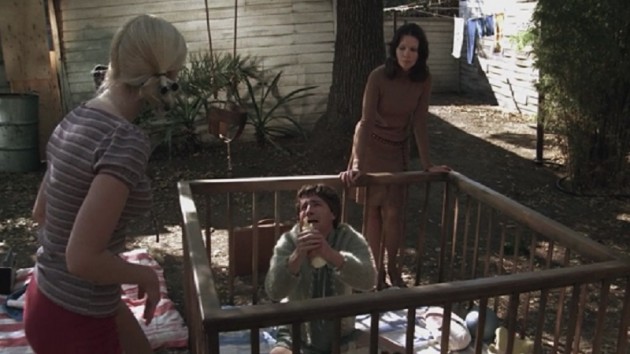
Baby gets fresh air
The Baby’s extraordinary resonating power today lies in its testing of the genre’s flexibility and the woes of misdirected desire. It isn’t just proven by overzealous social workers who incline toward the discovery of Satanic covens in our midst (these things come and go in cycles and usually very far from Salem, Mass.); it also lies in the politically correct policy-making machine within Governments which now insist on extended maternity and paternity leave (almost zero takeup in the UK of the latter…) and also provide support for fatherless —or other forms of— alternative families. And what begins in this story as the depiction of an apparently misandric world concludes on a decidedly misogynistic note.
Not only does The Baby leave unresolved the intrafamilial issues it raises, in the long tradition of melodramatic narrative; it poses a wider problem outside that context, specifically within the agency of Government, which, it suggests, isn’t merely repressive but potentially murderous (and, in its own peculiar fashion, horribly perverted). The gamut of femininity portrayed in this narrative is firmly within the realm of the pathological; motherhood is run riot; marriage is a disaster of infantilising retardation for the male child –and the husband; women are clearly perverted and mad. That the film’s pathetic text ultimately sides with the possessive Mrs Wadsworth over the bizarre machinations of her demonic Other (relational as well as oppositional, as Berenstein would have it), the narcissistic Judith and ‘bereaved’ Ann, is a statement of rare subtlety —if not outright progressive contradiction— which has implications for the continuing use of melodrama as an ironic mode to express not merely patriarchy’s fear of the feminine (and desires both fulfilled and transgressed) but the outrageous reaches of fortune in the contemporary family and society at large. Perhaps, as this film seemed to be telling us, we all occupy a society of dangerously arrested development. Out of the mouths of babes.
Bibliography
Books
Basinger, Jeanine (1993). A Woman’s View: How Hollywood Spoke to Women 1930-1960. London: Chatto & Windus.
Doane, Mary Ann (1987). The Desire to Desire: The Woman’s Film of the 1940s. London: MacMillan Press.
Langford, Barry (2005). Film Genre: Hollywood and Beyond. Edinburgh: Edinburgh University Press.
Levin, Ira (2000). The Stepford Wives. London: Bloomsbury Publishing.
Mast, Gerald, Marshall Cohen, and Leo Braudy (eds.) (1992). Film Theory and Criticism (4th ed.) New York: Oxford University Press.
Peary, Danny (1981). The Book of Cult Movies: The Classics, the Sleepers, the Weird and the Wonderful. New York: Gramercy Books.
Wicking, Chris and Tise Vahimagi (1979). American Vein: Directors and Directions in Television. New York: EP Dutton.
Articles
Berenstein, Rhona, “Mommie Dearest: Aliens, Rosemary’s Baby and Mothering,” Journal of Popular Culture, Fall 1990: 24 (2) 55-73. Wiley Online Library. Accessed 13 April 2016.
Elsaesser, Thomas, “Tales of Sound and Fury: Observations on the Family Melodrama,” 1972, reprinted in Mast, Cohen and Braudy,1992: 512-535.
Lee, Benjamin, “The Hand that Rocks the Cradle,” The Guardian, Film & Music, 08 April 2016: 12-13.
Nowell-Smith, Geoffrey. “Minnelli and Melodrama,” Screen, Summer 1977, 18 (2): 113-118.
Rosen, Marjorie, “Movies, Mommies, and the American Dream,” Film Comment, 1973: 10, 13-14.
Notes
- The original online citation for this no longer available. It was in part a Levin bio but the site is down. ↩

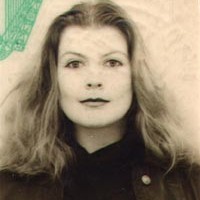

_400_258_90_s_c1.jpg)
